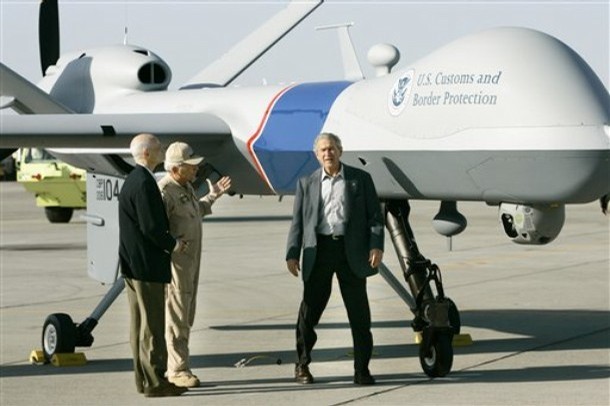Killing people from afar has always been the safest bet in any kind of murderous situation — the longbow ended the age of chivalrous knights, and the firearm put the archer out of work — even a rock in a sling could put bad shit on a much bigger, uglier opponent.
In fact, an entire movie franchise was built around unmanned machines killing humans from afar, or up close, proximity doesn’t matter to a piece of equipment.

(Illustration of a way-dumb-looking George Jr. with recon drone found here).
The US war effort has been highly enhanced with the use of UAVs, or unmanned aircraft, or just plain, drones, and since President Obama took office, the drone war in the Afghan/Pakistan theater of operations has steadily increased until the operations have nearly become common place.
From Wired magazine’s Danger Room blog: According to local reports, the drones fired up to 12 missiles in the latest attack, killing as many as 14 people. If those estimates are right, it brings September’s death toll to 60. The drones have killed up to 600 people in 2010 in 66 strikes. With two and a half months left in the year, the rate of robotic attacks has nearly doubled since 2008.
In none of the recent attacks has any “high value” people been killed, although children, women, old men, dogs, have been splattered in so-called collateral damage.
Read Jane Meyer’s in-depth piece on the US drone operation in the New Yorker here.
And closer to home, the US has added drones to patrol the skies (and ground) along the Mexican border as a nasty-assed drug war seems to never end down there.
These machines, though, are still just damn machines.
In August, a drone got out-of-hand above the US capitol — drones after the Pentagon?
From the AP:
The U.S. military almost launched fighter jets and discussed a possible shoot-down when an errant Navy drone briefly veered into restricted airspace near the nation’s capital last month, a senior military official said Thursday.
…
“Do you let it fly over the national capital region? Let it run out of gas and hopefully crash in a farmer’s field? Or do you take action and shoot it down?” said (Navy Adm. James Winnefeld Jr., head of Northern Command) Winnefeld. “You don’t want to shoot it down over a populated area if you can avoid it. We were going through all of that calculus.”
…
“We can’t move quickly enough for me to solve this problem,” Winnefeld said. “We need to push forward into getting the technology and the permission and the comfort level up to where we can do this as a matter of routine. This is where the future is going.”
And then what?